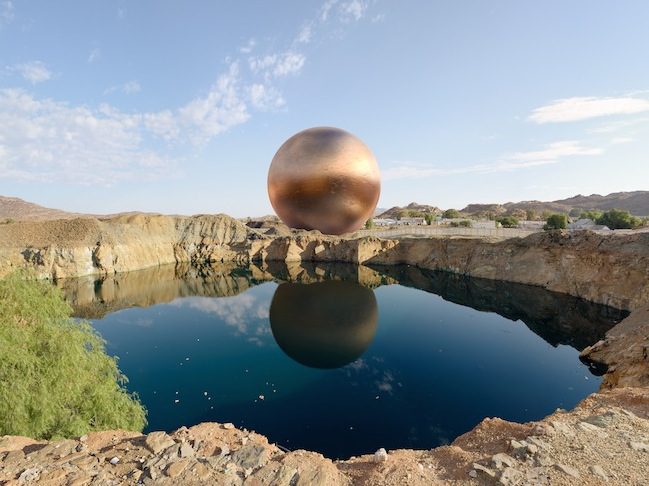Brundyn+, Cape Town, South Africa
04 Dec 2014 - 24 Jan 2015

West O’okiep Mines, Okiep (1862 to the early 1970s) 284,00 tonnes of copper extracted 2014 Lightjet Print - Fujicolor Crystal Archive Matte 140 x 175 cm Edition of 5, courtesy: Brundyn+
Brundyn+ present For What It’s Worth,an exhibition of photographic works by Dillon Marsh. Marsh explores a pertinent part of the history of South Africa, one that is effectively shaped by the mining of natural resources such as copper, gold and diamonds. From the discovery of diamonds in Kimberley in the 1800s, the inhumane living conditions of miners under apartheid rule, and the recent Marikana shootings, activities in and around mines seem to correlate with the current political conditions of the state. He critiques the process by visualising the total amount of raw material extracted from specific mines. Marsh’s juxtaposition lays bare the startling reality of how little is actually extracted relative to the amount of damage inflicted (to both the natural landscape and the miners themselves). The titles of Marsh’s works present statistical information about the mines. Elaborating, the artist states that: South Africa’s first ever commercial mine, the Blue Mine in Springbok, began operating in 1852. More mines opened soon after as copper deposits were discovered in the surrounding areas. This, in turn, boosted the development of small towns in a relatively remote area of the country, as workers settled nearby. By 2007, however, most of these mines had run their course and production had stopped almost completely. This presents an uncertain future for the towns and people of the region. Upon engaging with the images, the viewer is aware that 3 535 tonnes of copper were extracted from the Blue Mine in Springbok between 1852 to 1912; or that West O’okiep Mine in Okiep provided 284 000 tonnes of copper between 1862 and the early 1970s. These amounts appear colossal, however, when contrasted against the carefully compiled imagery of this data, the gigantism of the numbers suddenly diminishes. The representation of the amount of copper and diamond mined at these various locations is an indication of the imperial capitalism that motivated the existence of these structures. Through the silence that has poignantly been captured, the lack of inclusion of human beings, the ghosts and souls of the occupiers of the space are felt through the photographic image. For All It’s Worth thus speaks to the fact that most of the mines are no longer in use, and most of the towns seem desolate and lack immediately visible human life. The land was mined and exploited for all its worth, and then deserted. Some exist as monuments, signifying the reinforcement of a capitalist society and economy driven state, while others are just simply forgotten or never even occupied the consciousness of the South African public. Dillon Marsh (b. 1981) was born in Cape Town where he continues to live and work. In 2003, he obtained a Bachelor’s Degree in Fine Art from the University of Stellenbosch. For What It’s Worth (2014), shown at Brundyn+, Cape Town, is Marsh’s third solo exhibition, following Landmarks I (2012) at Black Projects, Cape Town and Lay of the Land (2011) at the AVA Gallery, Cape Town. Marsh has participated in a number of selected group exhibitions, including Pangea: New Art From Africa and Latin America (2014) at the Saatchi Gallery, London; Present Tense (2013) at the Next Future Festival, Gulbenkian Foundation, Lisbon; ExtraOrdinary (2013) at Noorderlicht in the Netherlands and Material/Representation (2012) at Brundyn + Gonsalves in Cape Town. Brundyn+
170 Buitengracht Street,
Cape Town